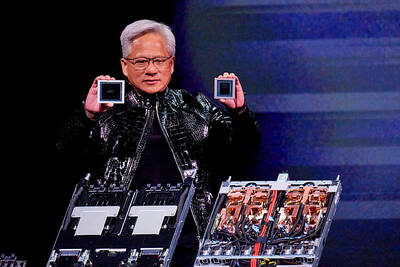Faced with layoffs and wage cuts as falling demand in the West hits the country’s vast manufacturing sector, the workers who have powered China’s breakneck growth are refusing to go quietly.
Over the past month, thousands of factory workers in China’s southern manufacturing heartlands have wrested concessions from employers facing shrinking exports and rising costs in a wave of labor unrest.
In Shenzhen, workers recently gathered at the office of labor rights organization Little Bird to debate a possible strike at a factory that employs them to demand better overtime pay and compensation.
“We have never experienced this situation. We want to learn the different methods for protecting our rights,” said Ran Lin, 30, who spends 11 hours a day, six days a week testing thousands of circuit boards on an assembly line.
Ran, who supplements his 2,000 yuan (US$315) monthly wage by working overtime at the Hong Kong-invested Dongguan Yong Jie Electronics Co Ltd factory, said the company had reduced perks such as meals and housing, even as the cost of living rose.
“We made contributions to economic development. We gave so much to the company. I hope they can give us suitable compensation,” Ran said.
As a manufacturing slowdown forces employers to cut back on benefits and lay off staff, workers are reaching out to grassroots groups, such as Little Bird, and even -government-linked agencies that offer legal advice and address complaints.
“Workers’ recognition of protecting their rights has increased. They have learned to unify,” Little Bird founder Wei Wei said.
Wei said the dense concentration of factories in China’s Guangdong Province had helped to spread news of the strikes, which emboldened workers.
Thousands of workers in Guangdong and elsewhere downed tools last month as factories hit by slowing demand in the US and Europe passed the pressure of rising costs and falling orders on to staff.
China’s manufacturing activity contracted last month for the first time in 33 months, as the export-led economic growth moderated to 9.1 percent in the third quarter from 9.5 percent in the previous quarter due to falling demand.
The Chinese Communist Party fears an independent labor movement could threaten its grip on power, so it only allows only one, government-linked trade union.
However, activists say government officials have been more sympathetic to individual grievances against factories, especially those funded by foreign firms or investors from Taiwan and Hong Kong.
“The government is afraid of simmering grievances. They don’t want workers to go on the streets or to demand trade unions,” said Debby Chan of Hong Kong-based Students and Scholars Against Corporate Misbehaviour.
Authorities have addressed concerns of workers by giving more teeth to a revised labor contract law, consulting industry groups and allowing courts to handle disputes.
And in an apparent response to recent unrest, authorities in Shenzhen recently announced plans to hike the minimum wage by 14 percent to 1,500 yuan per month from January, following a 20 percent rise in April.
Geoffrey Crothall, a spokesperson for the Hong Kong-based China Labour Bulletin, said some of the recent action showed a new level of sophistication.
He cited the example of workers at five PepsiCo bottling plants across the country who protested on the same day after the US beverage giant sold its plants in China.
“That is a level of organization that we’ve not really seen before, in terms of coordination of factories in different parts of China,” Crothall said.
In strikes last year against Japanese companies, workers cloaked their protests in anti-Japanese rhetoric to make them more acceptable to the government.
“They know it’s a motivating tool to get people on their side. Chinese workers are quite politically savvy,” Crothall added.
At a Shenzhen factory owned by Hong Kong women’s underwear maker Top Form International, last month hundreds of workers refused to return to their sewing machines for several days until management paid every worker 1,000 yuan.
“They swear at us. They never give us overtime. Why should we work?” one of the strikers said outside the aging green factory building.
Another two-week strike last month by nearly 1,000 workers, which paralyzed a Shenzhen factory invested by Japanese watchmaker Citizen Watch Co, revolved around rest breaks.
Managers made employees work additional time without pay to make up for breaks, which lasted 15 minutes every two hours, workers said. They returned after talks negotiated 70 percent pay for the rest periods.
Deng Shiping, who joined a strike of thousands against a -Taiwan-invested electronics factory last year, said organizing was made easier since everyone lived together in dormitories — a typical arrangement for migrant workers.
Workers chose representatives to inform other shifts and departments about the planned strike.
“There was no leader, it was us — the workers — all together,” he said.

Nvidia Corp chief executive officer Jensen Huang (黃仁勳) on Monday introduced the company’s latest supercomputer platform, featuring six new chips made by Taiwan Semiconductor Manufacturing Co (TSMC, 台積電), saying that it is now “in full production.” “If Vera Rubin is going to be in time for this year, it must be in production by now, and so, today I can tell you that Vera Rubin is in full production,” Huang said during his keynote speech at CES in Las Vegas. The rollout of six concurrent chips for Vera Rubin — the company’s next-generation artificial intelligence (AI) computing platform — marks a strategic

REVENUE PERFORMANCE: Cloud and network products, and electronic components saw strong increases, while smart consumer electronics and computing products fell Hon Hai Precision Industry Co (鴻海精密) yesterday posted 26.51 percent quarterly growth in revenue for last quarter to NT$2.6 trillion (US$82.44 billion), the strongest on record for the period and above expectations, but the company forecast a slight revenue dip this quarter due to seasonal factors. On an annual basis, revenue last quarter grew 22.07 percent, the company said. Analysts on average estimated about NT$2.4 trillion increase. Hon Hai, which assembles servers for Nvidia Corp and iPhones for Apple Inc, is expanding its capacity in the US, adding artificial intelligence (AI) server production in Wisconsin and Texas, where it operates established campuses. This

US President Donald Trump on Friday blocked US photonics firm HieFo Corp’s US$3 million acquisition of assets in New Jersey-based aerospace and defense specialist Emcore Corp, citing national security and China-related concerns. In an order released by the White House, Trump said HieFo was “controlled by a citizen of the People’s Republic of China” and that its 2024 acquisition of Emcore’s businesses led the US president to believe that it might “take action that threatens to impair the national security of the United States.” The order did not name the person or detail Trump’s concerns. “The Transaction is hereby prohibited,”

Garment maker Makalot Industrial Co (聚陽) yesterday reported lower-than-expected fourth-quarter revenue of NT$7.93 billion (US$251.44 million), down 9.48 percent from NT$8.76 billion a year earlier. On a quarterly basis, revenue fell 10.83 percent from NT$8.89 billion, company data showed. The figure was also lower than market expectations of NT$8.05 billion, according to data compiled by Yuanta Securities Investment and Consulting Co (元大投顧), which had projected NT$8.22 billion. Makalot’s revenue this quarter would likely increase by a mid-teens percentage as the industry is entering its high season, Yuanta said. Overall, Makalot’s revenue last year totaled NT$34.43 billion, down 3.08 percent from its record NT$35.52